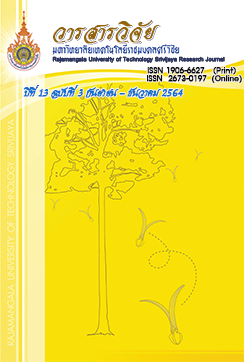Effects of Ground Rubber Tire and Natural Rubber Contents on Mechanical Properties of Thermoplastic Elastomer
Keywords:
thermoplastic elastomer, polymer blend, ground rubber tire, natural rubber, analysis of varianceAbstract
This research aimed to analyze the effects of rubber content and types (ground rubber tire and STR 5L) on mechanical properties of thermoplastic elastomer. In manufacturing the thermoplastic elastomer, a twin-screw extruder was used to blend mixture components. The thermoplastic elastomer pellets were then molded in a compression molding machine as sample panels. Analysis of variance (ANOVA) indicated that the ground rubber tire and STR 5L contents in the range of 30-70 wt% significantly (p-value < 0.05) affected modulus of rupture (MOR), modulus of elasticity (MOE), tensile strength (TS), tensile modulus (TM), maximum strain and hardness of the thermoplastic elastomer. The addition of ground rubber tire or STR 5L in range of 30-70 wt% resulted a decrease in MOR, MOE, TS, TM and hardness but an increase in the maximum strain of the thermoplastic elastomer. Furthermore, the thermoplastic elastomer blended with the ground rubber tire clearly provided higher MOR, MOE, TS, TM and hardness than blended with the STR 5L, whereas the thermoplastic elastomer with the STR 5L showed larger maximum strain. Finally, morphology of the thermoplastic elastomer revealed that plastic and rubber were immiscible polymer blends.
References
Abu-Abdeen, M. and Elamer, I. 2010. Mechanical and swelling properties of thermoplastic elastomer blends. Materials and Design 31: 808-815.
ASTM. 2014. ASTM D638-14. Standard Test Method for Tensile Properties of Plastics. ASTM International, West Conshohocken, PA.
ASTM. 2015. ASTM D2240-15e1. Standard Test Method for Rubber Property-Durometer Hardness. ASTM International, West Conshohocken, PA.
ASTM. 2016. ASTM D3389-16. Standard Test Method for Coated Fabrics Abrasion Resistance (Rotary Platform Abrader). ASTM International, West Conshohocken, PA.
ASTM. 2017. ASTM D790-17. Standard Test Methods for Flexural Properties of Unreinforced and Reinforced Plastics and Electrical Insulating Materials. ASTM International, West Conshohocken, PA.
Budnumpecth, T. and Tanpaiboonkul, N. 2016. Properties of lightweight concrete containing crumb rubber and cement replacing with fly ash from coal power plant. Veridian E-Journal, Science and Technology Silpakorn University 3(4): 62-75.
Campbell, D.S., Elliott, D.J. and Wheelans, M.A. 1978. Thermoplastic natural rubber blends. Natural Rubber Technology 9(21): 29-37.
Fazli, A. and Rodrigue, D. 2020. Waste rubber recycling: A review on the evolution and properties of thermoplastic elastomers. Materials 13: 782-812.
Homkhiew, C., Rawangwong, S., Boonchouytan, W. and Thongruang, W. 2018a. Mechanical and physical properties of thermoplastic natural rubber composites reinforced with rubberwood sawdust. SWU Engineering Journal 13(1): 107-122.
Homkhiew, C., Rawangwong, S., Boonchouytan, W., Thongruang, W. and Ratanawilai, T. 2018b. Composites from thermoplastic natural rubber reinforced rubberwood sawdust: Effects of sawdust size and content on thermal, physical, and mechanical properties. International Journal of Polymer Science Article ID 7179527: 1-11.
Jamil, M.S., Ahmad, I. and Abdullah, I. 2006. Effects of rice husk filler on the mechanical and thermal properties of liquid natural rubber compatibilized high-density polyethylene/natural rubber blends. Journal of Polymer Research 13(4): 315-321.
Kosonmetee, K. 2008. Preparation and mechanical properties of rubber composites made from thermoplastic natural rubber blended with jute fiber. Thesis of Master of Science in Polymer Science and Technology, Prince of Songkla University.
Legge, N.R., Holden, G. and Schroeder, H.E. 1987. Thermoplastic Elastomers: A Comprehensive Review. Hanser Publishers, New York.
Mohamed, W.Z.W., Baharum, A., Ahmad, I., Abdullah, I. and Zakaria, N.E. 2018. Mengkuang fiber reinforced thermoplastic natural rubber composites: Influence of rubber content on mechanical properties and morphology. Malaysian Journal of Analytical Sciences 22(5): 906-913.
Nunes, A.T., Santos, R.E., Pereira, J.S., Barbosa, R. and Ambrosio, J.D. 2018. Characterization of waste tire rubber devulcanized in twin-screw extruder with thermoplastics. Progress in Rubber Plastics and Recycling Technology 34(3): 143-157.
Pichaiyut, S., Nakason, C. and Vennemann, N. 2012. Thermoplastic elastomers-based natural rubber and thermoplastic polyurethane blends. Iranian Polymer Journal 21: 65-79.
Sae-Oui, P., Sirisinha, C., Sa-nguanthammarong, P. and Thaptong, P. 2010. Properties and recyclability of thermoplastic elastomer prepared from natural rubber powder (NRP) and high density polyethylene (HDPE). Polymer Testing 29: 346-351.
Saleesung, T., Saeoui, P. and Sirisinha, C. 2010. Mechanical and thermal properties of thermoplastic elastomer based on low density polyethylene and ultra-fine fully-vulcanized acrylonitrile butadiene rubber powder (UFNBRP). Polymer Testing 29: 977-983.
Sukontasukkul, P. and Wiwatpattanapong, S. 2009. Lightweight concrete mixed with superfine crumb rubber powder part 1: Insulation properties. The Journal of KMUTNB 19(3): 1-10.
Downloads
Published
How to Cite
Issue
Section
License
The content and information in the article published in Journal of Rajamangala University of Technology Srivijaya It is the opinion and responsibility of the author of the article. The editorial journals do not need to agree. Or share any responsibility.







